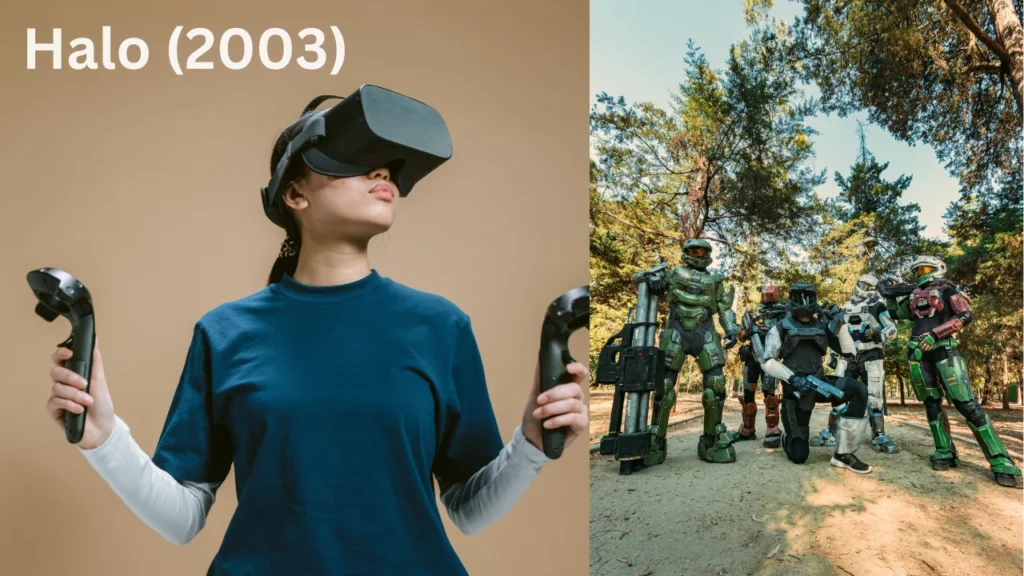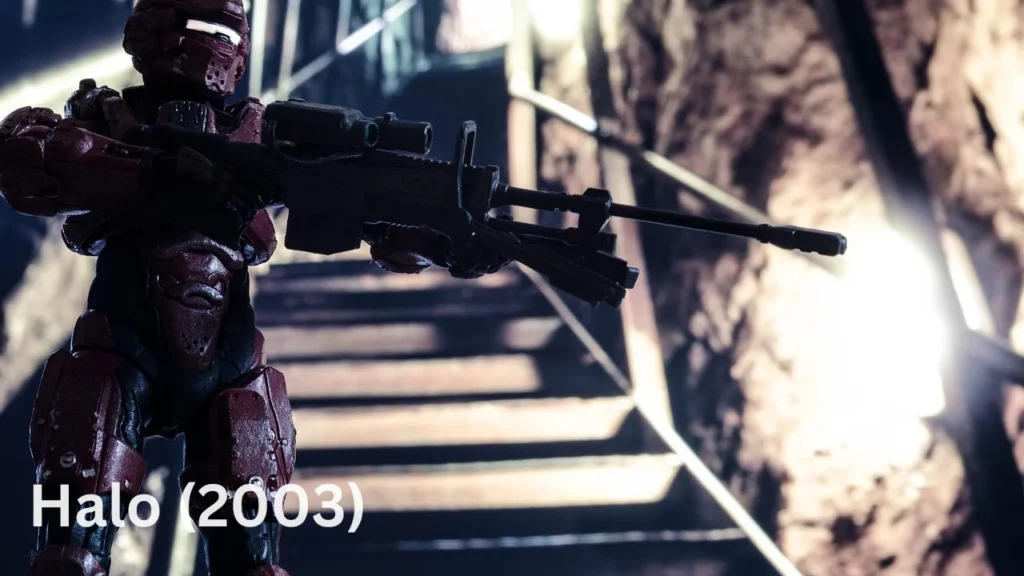Introduction
With its revolutionary design features, engrossing gameplay, and stunning visuals, Halo: Combat Evolved rewrote the rules of gaming in 2003. Among its other accomplishments, the incorporation of gaming icons and banners stood out as a crucial component of its allure. These parts weren’t just for show; they were essential for world-building, gameplay, and narrative. With its visually stunning and atmospheric weapon icons and faction banners, Halo 2003 Game Icons and Banners created an experience that was both practical and immersive.
What Was Halo: Combat Evolved?
Microsoft published Halo: Combat Evolved, a first-person shooter created by Bungie. Notable for its groundbreaking gameplay features, extensive plot, and entertaining multiplayer mode, it was first launched in 2001 for Xbox and re-released on PC in 2003. The game took place in the far future and chronicled the exploits of Master Chief, a super soldier who was assigned the mission of fighting an extraterrestrial alliance called the Covenant and deciphering the mysteries of a ringworld named Halo.
Especially in terms of visual design, Halo stood out from its competitors thanks to its meticulous attention to detail. Not only were the flags, insignias, and iconography aesthetically pleasing, but they also served as narrative devices that enriched the game and immersed players more into its world. The Covenant’s elaborate banners and the UNSC symbols’ clean, modern appearance mirrored the game’s themes of exploration, combat, and survival.
The Role of Game Icons in Halo (2003)
Enhancing Player Navigation
Clarity and functionality were the guiding principles in the design of the icons in Halo: Combat Evolved. They made it easy to navigate the game’s vast areas by highlighting important features like guns, vehicles, and objectives.
For instance, players could easily see the various weapon symbols during battle since they depicted distinct gun silhouettes. Similarly, players could properly plan their strategies since vehicle icons, such as those for the Warthog or Banshee, were immediately distinct.
Weapon Icons and Their Impact
Icons for weapons in Halo served a purpose, but they also contributed to the game’s realistic military feel. To represent the UNSC’s cutting-edge technology and the Covenant’s extraterrestrial weaponry, each icon was simple and modern. Players were drawn more into the tale by the contrast between alien and human designs, which highlighted the story’s primary struggle.
Vehicle Identification
In multiplayer situations, where decisions had to be made quickly, vehicle icons were vital. The easily identifiable symbols for United States Navy tanks, including the Scorpion and Warthog, allowed participants to better coordinate their tactics. In the midst of combat, players could easily tell allies from enemies because of the Covenant’s equally unique vehicles, such as the Ghost and Wraith.
Objective Markers and Immersion
The goal markers were designed using user-friendly icons that perfectly integrated with the game’s UI. These in-game indicators let players complete objectives without removing them from the action. Without being overly complicated, the icons conveyed all the necessary information to the gamer.
Faction Banners and Their Narrative Significance
The UNSC Emblem
One of the most prominent visual aspects of Halo was the UNSC symbol. It was a representation of the human army and had a strong, united design of an eagle surrounded by laurels. All of the player’s gear, including ships and uniforms, prominently featured this logo, which served to emphasize their participation in the human resistance against the Covenant.
Covenant Banners
Rich with symbolism, the Covenant banners revealed the theological and cultural variety of the extraterrestrial partnership. From the highest-ranking Elites to the lowest-ranking Grunts, the Covenant’s many factions were visually represented by their unique flags. Players could learn more about the aliens’ beliefs and intentions thanks to these banners, which expanded the game’s lore.
Color Palette and Design Principles
Halo: Combat Evolved’s emblems and banners mirrored the UNSC’s future military style with its use of primarily blue, green, and gray color palettes. Symbolizing their technological prowess and religious zeal, the Covenant banners, on the other hand, were adorned with purples and golds. The game’s narrative was improved by the intentional use of color in creating a visual differentiation between the two groups.
Visual Storytelling Through Insignias
Various factions’ insignias in Halo were painstakingly crafted to communicate their history and purpose. The United Nations Security Council emblem, for instance, represented the resiliency of the human race, while the glyphs of the Forerunners revealed some long-lost secrets about the Halo ringworld. These aesthetic touches gave the game depth and encouraged players to delve into its extensive backstory.
How Icons and Banners Enhanced Multiplayer Gameplay

Team Identification
Team identification through banners and iconography was vital in multiplayer modes. The usage of unique colors and symbols made it easy for players to identify friends and foes, which improved teamwork and strategy.
Customizable Emblems
Players were allowed to put their own stamp on Halo multiplayer with the addition of customisable insignia. For their in-game personalities, players could personalize them with a wide range of icons, colors, and backdrops. This element became synonymous with the series, encouraging players to express themselves and join in on the fun.
Strategic Visual Cues
During online matches, participants could use icons and banners as visual signals for strategy. Players might get an advantage over their opponents thanks to the easy access to crucial information provided by objective markers, team flags, and weapon spawn icons.
Legacy and Influence of Halo’s Visual Design
Impact on Subsequent Games
Halo: Combat Evolved established standards for visual design that have since been used by subsequent games in the series and by the gaming industry as a whole. Influential first-person shooters such as Call of Duty and Destiny popularized the natural and immersive usage of banners and iconography.
Fan Art and Community Creations
The thriving fan art community is proof of the evergreen popularity of Halo’s banners and symbols. Innumerable creative works have been influenced by these visual aspects, solidifying their standing as cultural icons. These include recreations of the UNSC insignia and reinterpretations of Covenant banners.
How Halo (2003) Set New Standards in Game Visual Design
Revolutionizing Icon Clarity in Gaming
Halo: Combat Evolved’s icon design was ahead of its time. Halo placed an emphasis on simplicity and clarity, in contrast to many games of the early 2000s that depended on visually chaotic or excessively styled elements. From weapons and vehicles to mission objectives, every icon was painstakingly designed to communicate its purpose immediately. Because of this meticulousness, players weren’t distracted by muddled graphics but rather could concentrate on the action.
Streamlined Weapon Indicators
Notable for their simplified style, the weapon symbols stood out. The crisp and easily recognizable depiction of each weapon’s profile allowed players to swiftly move between alternatives. This was especially important in high-stakes battle situations, when judgments made in the blink of an eye could decide victory or defeat.
Minimized Visual Noise
The purpose of Halo’s icon design was to reduce visual clutter. To keep gamers’ attention, icons eschewed superfluous details. Instead, they depended on striking shapes and contours to guarantee quick identification without compromising the game’s immersive visual style.
Integration with the User Interface
Icons’ smooth incorporation into Halo’s UI was a turning point. The icons blended seamlessly with the environment rather than standing out as separate features. As an example of how functionality and immersion were blended, weapon icons showed unobtrusively on the HUD.
The Role of Faction Banners in Storytelling

Banners were more than decorative elements in Halo:
Warfare Advances. Because they graphically represented the game’s ideas, cultural identities, and groups, they were vital to the tale. Banners like these allowed players to feel more invested in the story of the game.
Dynamic Placement in Game Environments
The game landscapes were designed with faction banners in mind to enhance storytelling. To demonstrate their supremacy and religious fervor, the Covenant would frequently display banners atop their strongholds. In the same vein, human bases began to fly UNSC flags, symbolizing resistance and optimism.
Cultural Depth in Banner Design
Intricate designs and alien script adorned the Covenant flags, showcasing the coalition’s diversity and complexity. Subtle clues on the Covenant factions’ hierarchies and values were offered by every design choice. The game’s enemies were better understood by players thanks to this degree of cultural richness.
Faction Unity and Pride
Along with representing their own factions, the flags helped to foster a feeling of camaraderie and pride. As they fought as UNSC soldiers, players were able to feel more connected to the story since their symbolic banners were always flying high, reminding them of their objective and allegiances.
Must Visit: Jojoy Toca Boca: A Seamless Gaming Experience for Families
Conclusion
The banners and emblems in Halo: Combat Evolved were crucial to the game’s success—they were more than just visual features. They improved the user experience, increased immersion, and established new benchmarks for visual design in games by merging functionality with storytelling. Their impact on future games and the lives of fans all across the world is undeniable. Whether it’s the narrative-rich faction flags or the intuitive weapon iconography, Halo’s design features showcase the power of careful and imaginative game design.
FAQs
What role did icons play in Halo: Combat Evolved?
Icons in Halo: Combat Evolved served as intuitive visual cues, helping players identify weapons, vehicles, and objectives efficiently during gameplay.
How did banners enhance the storytelling in Halo: Combat Evolved?
Banners visually represented the game’s factions, such as the UNSC and Covenant, enriching the narrative by showcasing their values, allegiances, and cultural identities.
Why are the UNSC emblems iconic in the Halo series?
The UNSC emblems symbolized humanity’s resilience and military strength, becoming a central element of the franchise’s futuristic and strategic aesthetic.
How did visual design in Halo improve multiplayer gameplay?
Distinct icons and faction banners helped players easily identify teams, objectives, and equipment in multiplayer mode, enhancing coordination and strategy.
What made the icons and banners in Halo: Combat Evolved unique for its time?
Their minimalistic yet functional design blended seamlessly with the game’s interface, prioritizing clarity and immersion while reflecting the futuristic military theme.

My name is Nancy Rose, and I’m a passionate blogger at Techiwell.com, a platform dedicated to exploring technology, business, entertainment, and general topics. I strive to create engaging, insightful, and informative content to keep readers updated and inspired in our fast-changing world.
1 thought on “Halo 2003 Game Icons and Banners: A Visual Revolution in Gaming”